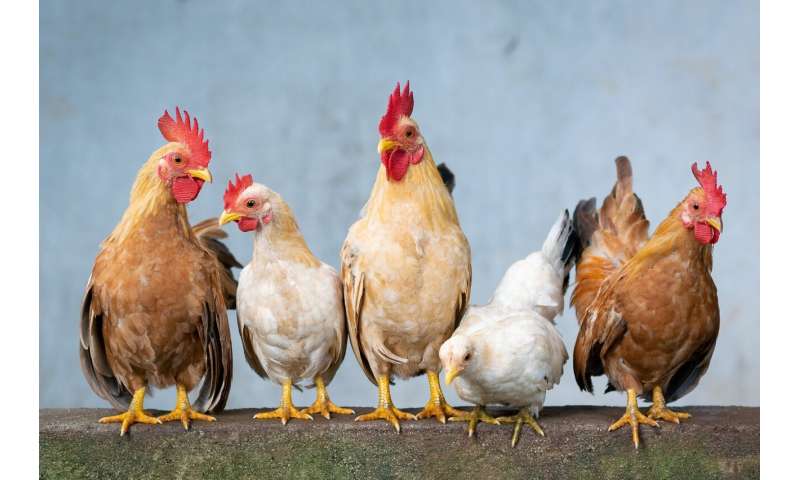
"Bird-brain" is a term used to describe someone scatty, indecisive, forgetful. But in an innovative new study published in Comparative Biochemistry and Physiology—Part D: Genomics and Proteomics , researchers found that the behavior of chickens is far from random. In fact, it appears to be strongly linked to non-genetic modifications involving key genes in the chicken brain.
To the untrained eye, chickens can seem like rather daft birds—strutting, flapping and pecking at random as they go about their lives. But in this study, researchers from Linköping University in Sweden and the University of Bern in Switzerland used a unique system of radiofrequency sensors and tracking devices to record and analyze the movements and activity levels of egg-laying hens.
The study took place at a research facility with commercial free-range conditions in Switzerland, where the hens' environment could be relatively controlled to eliminate factors that might skew the data.
Three types of data metrics were used to describe the hens' behavior: their consistency in day-to-day movements around the barn and outside space (their 'entropy'), the similarity over days in terms of the times and locations of their activities ('dynamic time warping, or DTW), and their 'leading index' – a measure of hens' inclination to lead or follow others from one area of the pen to another.
Emerging behavior patterns
Although the chickens were all of the same commercial breed and age, and all had access to the same environment, the data revealed emerging patterns of behavior: some hens became more active than others; some seemed to be in charge, leading others from inside the barn to outside and back again, while other hens preferred to follow or stay put. Most of the hens spent some of their days outside of the barn, but some were outside up to 87% of their time, while a few never left the barn at all.
On the face of it, all of the chickens were the same, so why did some behave differently to others? What is it about bird brains that causes different behaviors?
Dr. Toscano from Bern University said: "We expected that hens would vary in the types of movement, but we did not expect the incredibly diverse and consistent behavioral patterns that we have been finding. Now, as a result of this research, these patterns seem to be grounded in definitive biological processes."
The answer may lie in the epigenetics of their brain cells
Epigenetics looks at how the expression of DNA can be changed—not by mutating the genetic code, but by modifying molecules in and around the DNA. A common type of modification is methylation of the histones—the addition of methyl groups to the proteins around which DNA is folded to form chromosomes. The extent of histone methylation can affect how other proteins interact with the DNA, thus switching genes on or off, or acting like a 'dimmer switch' to fine-tune expression.
Epigenetic modifications are linked to behavior
Dr. Guerrero-Bosagna, an avian epigenetics expert from Linköping University said: "We examined the nidopallium—a part of the avian brain equivalent to the pre-frontal cortex in mammalian brains, which is responsible for complex cognitive behavior, including decision-making."
The researchers noticed that hens' behavioral patterns were reflected in the epigenetics of the neuron (nerve) cells: distinct patterns of differentially methylated regions, or DMRs, were associated with certain types of behavior.
For example, particular DMR patterns were seen in the genomes of chickens that spent more time outside, but different patterns were seen in those that tended to stay inside the barn. They also saw epigenetic differences in terms of whether an animal was a leader or follower.
Dr. Guerrero-Bosagna said: "It's too early to speculate why different epigenetic patterns are seen with different behaviors, but the evidence of a link is very interesting indeed."
So does epigenetic modification cause different behaviors?
When the researchers explored the types of genes affected by DMRs in chickens with different behavior patterns, these were not random. In entropy, genes affected by DMRs related mainly to cell cycle checkpoints, Leading Index to mitochondrial function genes, and DTW to the regulation of gene expression.
"In other words," said Dr. Guerrero-Bosagna, "it is possible that each of the three types of emerging behavior we studied could be caused by different biological functions and epigenetic patterns within neurons. Our results are quite exciting and will prompt further neurobiological research into understanding the development of behavior."
Explore further
Citation: Bird brain scientists find link between chicken behavior and epigenetics (2020, July 22) retrieved 22 July 2020 from https://ift.tt/2E2PW72
This document is subject to copyright. Apart from any fair dealing for the purpose of private study or research, no part may be reproduced without the written permission. The content is provided for information purposes only.
"behavior" - Google News
July 22, 2020 at 08:54PM
https://ift.tt/2E2PW72
Bird brain scientists find link between chicken behavior and epigenetics - Phys.org
"behavior" - Google News
https://ift.tt/2We9Kdi
Bagikan Berita Ini














0 Response to "Bird brain scientists find link between chicken behavior and epigenetics - Phys.org"
Post a Comment